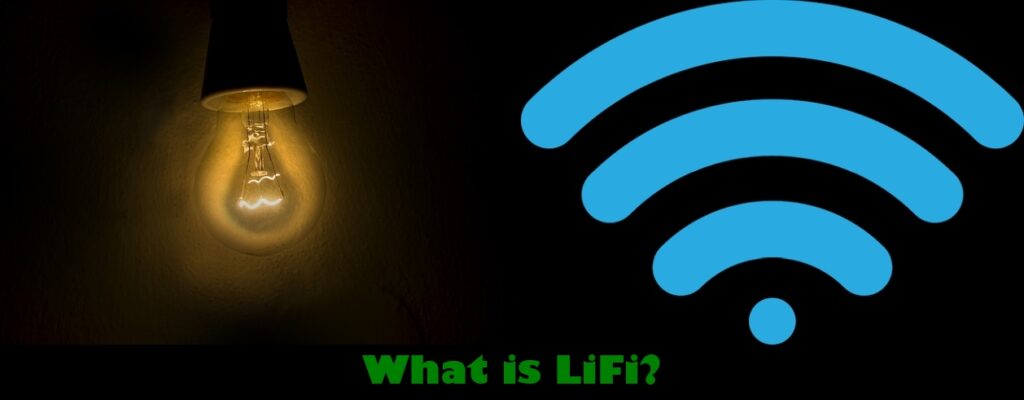What is LiFi?
LiFi is a Visible Light Communication (VLC) technology that offers wireless data transmission over LED light bulbs. It was developed in 2011 by Harald Haas, a Professor at the University of Edinburgh. In this article, we will explore how Li-Fi works, its benefits and applications in everyday lives.
The main difference between Wi-fi and Li-fi is that while Wi-fi transmits through radio waves, Li-fi uses visible light communication to transmit data. Data transmission happens by modulating the intensity of the transmitter’s LED bulb to produce binary digits which are then decoded at the receiver’s end to extract information. This modulation can be done rapidly giving rise to speeds that are much higher than wi-fi.

The general public will be able to use LiFi beginning in 2022.The store offers coupons and incentives based on the location of the customer in the store by using LiFi. LiFi capability is also being discussed by several large mobile companies such as Apple.There are many industries where LiFi works with partners, including defense, healthcare, lighting, IT infrastructure, telcos, and device integrators.
How Li-Fi Works?
Li-Fi technology operates through the use of Light Emitting Diodes (LEDs) to send data signals. The process involves three main components:
1. LED Transmitter
At the core of Li-Fi technology is the LED light bulb, which acts as the transmitter. When an electric current passes through the LED, it emits rapid pulses of light, which are not visible to the naked eye.
2. Photo-Detector Receiver
On the receiving end, a photodetector is employed, typically a photodiode, which is responsible for detecting the changes in light intensity. The photodetector then converts these light signals into electrical signals.
3. Signal Processing Unit
The signal processing unit works as a bridge between the LED transmitter and the photodetector receiver. It processes the electrical signals from the photodetector and translates them back into data, enabling communication between devices.
What is the importance of LiFi?
Li-Fi technology has been making waves in recent times, capturing the attention of tech enthusiasts and experts alike. This revolutionary technology offers a plethora of advantages that could reshape the way we interact with the digital world. Let’s delve into the key reasons why Li-Fi is gaining so much interest:
1. Unprecedented Data Speeds: A Speed Revolution
When it comes to data transmission speeds, Li-Fi sets an unprecedented benchmark. Capable of reaching several gigabits per second, Li-Fi surpasses traditional Wi-Fi networks by leaps and bounds. This incredible speed makes Li-Fi an ideal choice for data-intensive tasks such as video streaming, large file transfers, and even power-hungry virtual reality applications.
2. Enhanced Security: A Shield of Light
Security is a paramount concern in the digital age, and Li-Fi offers a promising solution. Unlike Wi-Fi, which uses radio waves susceptible to unauthorized access and interference, Li-Fi’s signals cannot penetrate solid objects. This inherent limitation acts as a shield of light, providing an extra layer of security for sensitive data transmission.
3. Efficient Use of Spectrum: Brighter Bandwidth Horizons
Traditional RF communication often faces challenges due to the scarcity of available spectrum. Li-Fi, however, taps into the vast and unregulated visible light spectrum, minimizing congestion and maximizing the efficient use of available bandwidth. This opens up brighter horizons for data transmission without the usual constraints.
4. Safe for Health and Environment: Lighting the Way to Safety
With growing concerns about the impact of technology on human health and the environment, Li-Fi offers a breath of fresh air. Operating on visible light wavelengths, it ensures that both human health and the environment remain unharmed, making it a more sustainable and responsible choice.
5. No Electromagnetic Interference: Light’s Gentle Touch
Li-Fi’s light-based communication eliminates electromagnetic interference with sensitive electronic devices. This gentle touch makes it an ideal solution for critical operations in environments where traditional wireless technologies could wreak havoc.
6. Li-Fi in Internet of Things (IoT): Illuminating the IoT Landscape
As the Internet of Things (IoT) continues to expand, the need for reliable and high-speed communication becomes more pronounced. Li-Fi holds the potential to be a significant player in enabling seamless communication between the vast network of IoT devices, enhancing efficiency and connectivity.
7. Reducing Digital Divide: Lighting Up Remote Regions
One of the most promising aspects of Li-Fi technology is its ability to bridge the digital divide in areas with limited internet infrastructure. Its low-cost implementation and capacity to transmit data over long distances through LED lighting can bring connectivity to remote and underserved regions, empowering communities around the world.
8. Immune to Radio Frequency Interference: A Beacon in Challenging Settings
In environments where radio frequency interference poses challenges, such as hospitals and airplanes, Li-Fi shines as an effective alternative. Its immunity to such interference ensures uninterrupted connectivity and smooth operations.
Li-Fi Technology in Real-World Applications: Lighting the Path Ahead
While still in its early stages of development, Li-Fi is already showing great promise in a variety of real-world applications:
1. Smart Lighting Systems: A Brighter and Smarter Future
The integration of Li-Fi into smart lighting systems allows LED light bulbs to serve not only as sources of illumination but also as data communication points. This innovation paves the way for energy-efficient buildings and smart cities, where connectivity and sustainability go hand in hand.
2. Indoor Navigation: Guiding the Way
Li-Fi’s precise indoor positioning and navigation capabilities make it an ideal solution for locations where GPS signals might be unreliable, such as inside malls, airports, and underground structures. Li-Fi helps people find their way with ease and accuracy.
3. Underwater Communication: Illuminating the Depths
Radio waves struggle to penetrate water, making communication underwater a challenge. However, Li-Fi’s light-based technology brings a ray of hope by enabling efficient data transfer between underwater devices, unlocking new possibilities for exploration and research.
4. Li-Fi in Healthcare: A Beacon of Safety
The interference-free communication offered by Li-Fi makes it well-suited for medical environments where sensitive equipment and patient safety are of utmost importance. Li-Fi ensures critical data transfer without any compromise.
5. Transportation: Lighting Up Journeys
Integrating Li-Fi technology into public transport systems enhances passengers’ experiences by providing seamless connectivity and access to real-time information during their journeys. Li-Fi keeps travelers connected, entertained, and informed.
6. Li-Fi in Education: Illuminating Minds
In educational settings, Li-Fi can revolutionize the way students access information and interact with their learning materials. By creating more engaging and immersive classrooms, Li-Fi sparks curiosity and fosters a love for learning.
FAQs about Li-Fi Technology:
Is Li-Fi Technology the same as Wi-Fi?
No, Li-Fi and Wi-Fi are distinct wireless communication technologies. While Wi-Fi uses radio waves to transmit data, Li-Fi uses visible light.
Can Li-Fi work in the dark?
No, Li-Fi requires a source of visible light to function and cannot operate in complete darkness.
Is Li-Fi faster than Wi-Fi?
Yes, Li-Fi has the potential to achieve significantly higher data speeds compared to Wi-Fi, making it an enticing option for data-intensive applications.
Is Li-Fi secure?
Absolutely! Li-Fi offers enhanced security as its signals do not pass through walls, reducing the risk of unauthorized access and interference.
What are the challenges of Li-Fi technology?
Li-Fi faces challenges such as the need for a clear line of sight between the transmitter and receiver, as well as potential signal interference from ambient lighting.
Is Li-Fi widely adopted yet?
Li-Fi is still in its early stages of development, and while it shows immense promise, it is not yet widely adopted. However, ongoing research and advancements suggest a bright future for its applications.
